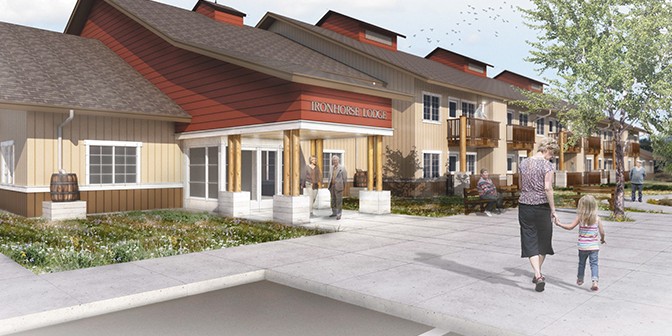(Photo rendering by Iron Horse Lodge in Prineville)
Path to Net Zero incentives and resources support new commercial construction that exceeds Oregon building code standards. A new offer from Energy Trust of Oregon is helping Oregon building owners design and construct some of the most energy-efficient new commercial buildings in the nation. Iron Horse Lodge in Prineville an example of local company using Pat to Net Zero.
Projects underway across Oregon include a wide range of building types like commercial buildings, low-income housing and rural schools.
“Our goal is to hedge against rising operating costs. This is critical to the economic longevity of our project since our rents are restricted for the first 60 years. Path to Net Zero helps us counter rising costs, and is a key part of our business model,” said Rob Roy, co-operating partner of Pacific Crest Affordable Housing, the developer and owner of Iron Horse Lodge in Prineville. “Things with small cost differentials over code can have large energy-saving impacts. LED lights and lighting controls are good examples.”
Energy-efficient design is already a part of Oregon building codes, but buildings often miss out on additional savings when building materials and systems are evaluated and designed individually rather than holistically.
Energy Trust’s Path to Net Zero tackles these challenges through a whole-building approach, and provides expert advisers throughout the design and construction process and financial incentives to help offset costs along the way. The result: high-performing buildings that surpass Oregon energy building codes by at least 40 percent. That means buildings would, over the course of a year, only consume the amount of energy produced on site.
“This is the future of commercial buildings,” said Jessica Iplikci, program manager, Energy Trust. “Many people don’t realize that commercial buildings consume 40 percent of all energy produced in the United States. We see net-zero design as a game-changer in commercial construction, and Energy Trust is leading the way.”
Launched just this year, eight Path to Net Zero buildings have already completed construction, and 30 additional projects have enrolled.
FROM PILOT TO FULL SCALE OFFERING
Path to Net Zero builds on expertise and lessons learned through a pilot phase from 2009 to 2014. Several pilot projects ultimately received Path to Net Zero certification through the International Living Future Institute, including:
• Chemeketa Community College in Salem
• Hood River Middle School
• June Key Delta Community Center in Portland
• EcoFlats Apartments in Portland
Jerry Vessello, capital project manager at Chemeketa Community College, has seen how Energy Trust’s approach can create an efficient and livable building. “Path to Net Zero allowed us to add natural ventilation and natural lighting which has led to a bright, well ventilated, comfortable and healthy building for our students, staff and instructors.”
MORE SUCCESSES AROUND THE STATE
Projects underway across Oregon include a wide range of building types like commercial buildings, low-income housing and rural schools.
“Our goal is to hedge against rising operating costs. This is critical to the economic longevity of our project since our rents are restricted for the first 60 years. Path to Net Zero helps us counter rising costs, and is a key part of our business model,” said Rob Roy, co-operating partner of Pacific Crest Affordable Housing, the developer and owner of Iron Horse Lodge. “Things with small cost differentials over code can have large energy-saving impacts. LED lights and lighting controls are good examples.”
Bill Steele, owner of Cowhorn Vineyard & Garden in Jacksonville, was able to cost-effectively design an expansion while reducing environmental impact. “We had a chance to minimize our imprint on the Earth, and why wouldn’t you take that chance?” said Steele. “It also seems like the right thing to do from both a brand perspective and a philosophical one. We can show people that it can be done. My old career was in Wall Street and what we’re doing is establishing a market.”
HOW IT WORKS
Path to Net Zero guides project participants through a series of easy steps, beginning with early design assistance and a facilitated design workshop that brings together the building team and an Energy Trust representative. This helps the building owner identify goals and challenges at the outset, with the full building team involved.
Energy Trust representatives then work actively with the design team, providing technical assistance, installation guidance and post-construction monitoring to help the owner pinpoint problems and implement changes.
Energy Trust provides financial incentives at each stage to help offset upfront costs that might otherwise make such an in-depth approach more expensive, particularly for smaller business.
Path to Net Zero targets energy-efficiency savings of 40 percent better than Oregon code for most types of buildings. That number represents an interim step identified by the nonprofit group Architecture 2030 to drive commercial development toward a net-zero energy rating by the year 2030.
For more information on Path to Net Zero, including videos describing completed projects and instructions on participating, visit the Energy Trust website.
About Energy Trust
Energy Trust of Oregon is an independent nonprofit organization dedicated to helping utility customers benefit from saving energy and generating renewable power. Our services, cash incentives and energy solutions have helped participating customers of Portland General Electric, Pacific Power, NW Natural and Cascade Natural Gas save $1.7 billion on energy bills. Our work helps keep energy costs as low as possible, creates jobs and builds a sustainable energy future. Learn more at www.energytrust.org or call 1-866-368-7878.
Additional resources
• Architecture 2030—The 2030 Challenge
• New Buildings Institute—Zero Net Energy
• International Living Building Challenge—Net Zero Energy Building Certification
• American Institute of Architects—2030 Commitment





